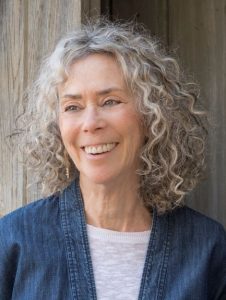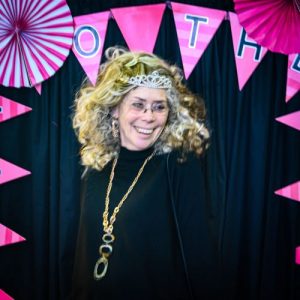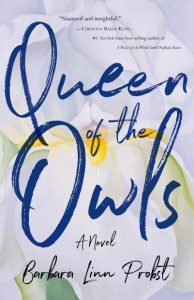Finding Myself at The Great Big Ball of Hair in Jefferson, Texas
 Barbara Linn Probst
Barbara Linn Probst
If you know what I’m referring to in the title of this piece, then you’ve been to the Pulpwood Queens’ Girlfriends Weekend, and you probably have a good idea what this essay will be about. But if you haven’t, and don’t, then read on.
On second thought, read on either way.
The Pulpwood Queens are a network of nearly 800 book clubs, originating in the south but with branches throughout the U.S. and beyond. At the heart of the enterprise is the one-of-a-kind Kathy L. Murphy, whose mission is to bring readers and authors together, promote literacy, and foster a community like no other through her monthly selections and annual Girlfriends Weekend. When I first heard about the Pulpwood Queens, my response—as a soon-to-be debut author, eager to connect with book clubs—was a surge of greedy excitement.
I write that, now, as a confession. Like all confessions, it brings both shame and relief. I can’t help cringing and wanting to apologize for the over-sized ambition that fueled so many of my actions.
I don’t know what portion of that ambition came from the endless webinars, articles, blogs, and Facebook posts that newly-minted novelists are subject to nowadays—each telling us what we should do, or could do, or what other authors are doing (and the accolades they’re achieving as a result). It’s hard to resist the fear of missing out, not doing enough, investing one’s time and heart and energy in a book that will end up being ignored.
 I don’t know if this is something every writer feels—the fragile and terrible longing for our words to reach people and make a difference, the anxiety and vulnerability as the reality of publication approaches—or if it’s a product of the culture I’m immersed in that keeps urging us to hustle, promote, compete. Nor do I know if it’s me, my specific personality. I’m high-drive, high-energy, and I’m used to excelling.
I don’t know if this is something every writer feels—the fragile and terrible longing for our words to reach people and make a difference, the anxiety and vulnerability as the reality of publication approaches—or if it’s a product of the culture I’m immersed in that keeps urging us to hustle, promote, compete. Nor do I know if it’s me, my specific personality. I’m high-drive, high-energy, and I’m used to excelling.
Perhaps it’s a confluence of all these forces, ego and passion and context. Or perhaps the reason doesn’t matter. The fact is that the craving to promote my book was burning in me with a ferocity that bordered on obsession. It led to some wonderful inspirations and moments of fearlessness, but it also led to offending some good people with my pushiness. Luckily, they had generous hearts and responded with big wallops of tough love that put me in my place. (If you’re reading this, you know who you are.)
That combination of courage, ambition, and belief in my book led me to send Kathy Murphy a copy of Queen of the Owls when it was still a Word document on my laptop. Knowing that she’d started out, twenty years ago, with a salon called Beauty and the Book, I had a hunch that my story would resonate with her, and it did. I was overjoyed to learn that Queen of the Owls would be a primary selection in the Spring of 2020. That also meant I was invited to the annual Girlfriends Weekend in Kathy’s home town of Jefferson, Texas.
I signed up right away. What a great opportunity to network, promote, sell. Clearly worth the time and expense of getting there from New York.
That’s the back story. Here’s what actually happened.
The spark was lit the first morning of the Girlfriends Weekend when three women from a book club in Mississippi, who were staying at the same bed-and-breakfast as I was, invited me to join them for breakfast. Their kindness put me at ease right away, and I found myself admitting to nervousness about the panel I was going to be on. What I really meant was: How could I describe my book in a way that would make people want to buy it and read it?
I didn’t say that, not overtly, but my three new friends had been to a dozen Girlfriends Weekends and had no doubt met plenty of authors equally anxious about the impression they would make. One of them, Karen, waved a dismissive hand at my concern. “Just tell us about you. Show us who you really are. That’s what we want to know. Get out of your comfort zone.”
If it wasn’t such a cliché, I’d say that her words struck me like a bolt of lightning. I thought of the safe, carefully crafted things I planned to say. The notion of taking the kind of risk Karen was talking about had never occurred to me.
Then a second, and larger, flash of lightning zapped me right to the core. This safe intellectual façade was exactly what my book’s protagonist had to confront and overcome.
I’d created a story about a woman who stepped outside the very defensive barrier that I was still hiding behind. I’d made my protagonist do what I myself hadn’t done—even though I believed and acted as if I had, even telling people that this was the source of the novel.
It was so astoundingly perfect that I knew I was smack in front of an important, intimate truth about the relationship between my writing and my being. I also knew, with absolute certainty, that I had to get up on that podium and expose my vulnerability. Reveal myself, just as my protagonist had done in Queen of the Owls.
“Get out of your comfort zone,” Karen repeated. Her companions nodded.
Show us who you really are.
And who was that? The aggressive, competitive newbie who wanted so much to succeed? Or someone else, waiting to be released from her protective isolation?
It started with putting on the tiara, mandatory for Girlfriends Weekend. Next came the leopard print leggings and Dolly Parton wig. Actors know this, but I didn’t—the way a costume can release you to be more yourself than you are in your regular garb. It makes no sense, but it’s true. In my big blonde hair, tiara, and bling, I became the Barbara I didn’t know I could be.
The theme for this year’s Girlfriends Weekend was Take it to the Limit. I’d set a tightly-controlled limit for myself—that comfort zone Karen had challenged me to defy—but maybe the limit was much farther out. Or maybe there was no limit.
Next thing I knew, I was jumping up to enter the Dolly Parton Look-Alike Contest. I was sure that no one who knew me would ever believe I’d done such a thing, and I could scarcely believe it myself. But the enormous, exuberant smile in the photos shows, and reminds me, that I did.
There was more.
In a burst of insight, I knew that Barbara-with-the-big-hair had to join hands with Barbara-the-writer. The two disconnected sides of myself had to connect, embrace one another. Flamboyant and reserved, external and internal—exactly what I’d said in Queen of the Owls, but now it was me, not my protagonist, who had to earn the right to proclaim that unity.
And more still.
There was a third point in the triangle of who you really are that had to be included in this unexpected chance to be truly present. Barbara-the-vulnerable-woman. I had to speak aloud, in public, about the pain that enabled me to write Queen of the Owls.
When it was my turn on the stage, I looked around at the room full of people who had come to Jefferson, Texas, from all over the country. I saw Kathy, whose generous heart had seen beyond the endless emails of an ambitious Yankee to the power of the story I wanted to share. I saw Latonia, who had modeled the kind of courage I needed. I saw Karen, smiling her encouragement.
I took the microphone from my co-panelist and spoke about my journey—about myself, not just about my book. Being seen as an owl, a sexless brain, instead of a desirable woman. The merciful healing that enabled me to write Queen of the Owls—and was still taking place, even though I hadn’t known that until I put on my tiara. My illusion about why I’d signed up for Girlfriends Weekend, and my humbled realization that it was for this—this moment of exposure, honesty, and participation.
Not to sell books or build my platform or impress book club members. To reveal myself. To be myself. And that mattered so much more, now, than whether anyone ever bought Queen of the Owls.
Holding that microphone and hearing my voice, I felt light, open, grateful for the gift of existence. I was glad Queen of the Owls wasn’t for sale yet, so I didn’t have to risk losing this special new freedom by rushing to the vendor’s table for a frenzy of selling-and-signing. Instead, I went around the room handing out the oversized Queen of the Owls magnets I’d brought for the attendees.
In case you’re wondering, the Great Big Ball of Hair “Take it to the Limit” Ball was the name of the extravaganza held on the final evening of the weekend. Outrageous costumes, line dancing, writers and readers whooping it up together under the purple and green strobe lights.
When the weekend was over, I didn’t make any dramatic resolutions to stop marketing Queen of the Owls. With publication drawing near, that would have been unrealistic, and foolish. But something was different.
I wanted people to know about Queen of the Owls because I thought it might speak to them, because I’d rediscovered what I’d felt in the beginning, before I lost my way—that writing is about giving, not getting.
Bio:
BARBARA LINN PROBST is a writer of both fiction and non-fiction, living on an historic dirt road in New York’s Hudson Valley. Her debut novel QUEEN OF THE OWLS (April 2020) is the powerful story of a woman’s search for wholeness, framed around the art and life of iconic painter Georgia O’Keeffe. QUEEN OF THE OWLS has been selected as one of the 20 most anticipated books of 2020 by Working Mother and will be the May 2020 selection for the Pulpwood Queens, a network of nearly 800 book clubs across the U.S. Her second novel, THE SOUND BETWEEN THE NOTES, will be published in April 2021. In her spare time, Barbara blogs for several award-winning sites for writers and is a serious amateur pianist. To learn more, please see www.BarbaraLinnProbst.com
QUEEN OF THE OWLS
 A chance meeting with a charismatic photographer will forever change Elizabeth’s life.
A chance meeting with a charismatic photographer will forever change Elizabeth’s life.
Until she met Richard, Elizabeth’s relationship with Georgia O’Keeffe and her little-known Hawaii paintings was purely academic. Now it’s personal. Richard tells Elizabeth that the only way she can truly understand O’Keeffe isn’t with her mind―it’s by getting into O’Keeffe’s skin and reenacting her famous nude photos.
In the intimacy of Richard’s studio, Elizabeth experiences a new, intoxicating abandon and fullness. It never occurs to her that the photographs might be made public, especially without her consent. Desperate to avoid exposure―she’s a rising star in the academic world and the mother of young children―Elizabeth demands that Richard dismantle the exhibit. But he refuses. The pictures are his art. His property, not hers.
As word of the photos spreads, Elizabeth unwittingly becomes a feminist heroine to her students, who misunderstand her motives in posing. To the university, however, her actions are a public scandal. To her husband, they’re a public humiliation. Yet Richard has reawakened an awareness that’s haunted Elizabeth since she was a child―the truth that cerebral knowledge will never be enough.
Now she must face the question: How much is she willing to risk to be truly seen and known?
Recipient of stellar advance praise from best-selling authors:
“A nuanced, insightful, culturally relevant investigation of one woman’s personal and artistic awakening, Queen of the Owls limns the distance between artist and muse, creator and critic, concealment and exposure.”
―Christina Baker Kline, #1 New York Times best-selling author of A Piece of the World and Orphan Train
“This is a stunner about the true cost of creativity, and about what it means to be really seen. Gorgeously written and so, so smart (and how can you resist any novel that has Georgia O’Keeffe in it?), Probst’s novel is a work of art in itself.”
―Caroline Leavitt, best-selling author of Pictures of You, Is This Tomorrow and Cruel Beautiful World
“Readers will root for Elizabeth―and wince in amusement at her pratfalls―as she strikes out in improbable new directions … An entertaining, psychologically rich story of a sometimes giddy, sometimes painful awakening.” ―Kirkus Reviews
Category: On Writing






























